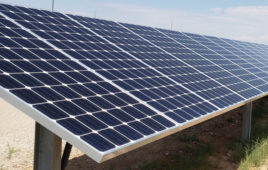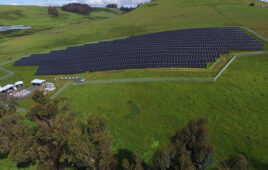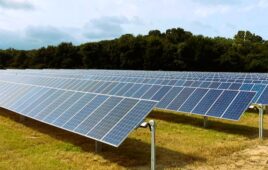By Manish Nayar, founder and managing partner, OYA Solar
The COVID-19 pandemic has shown us the massive unforeseeable impact that unknown viruses can have on national and global supply chains. Economies around the world are at a standstill as several billion people have been told to physically distance in an attempt flatten the curve, the effects of which we do not yet fully comprehend. The U.S. has not been left unscathed. To date, nearly 26 million Americans have filed for unemployment benefits as a result of the astonishingly swift economic shutdown.
The country’s efforts to date have rightly been to manage the immediate health and economic needs of our citizens. But the federal government must now start thinking about its strategy to revive the economy once it is safe to get back to work. If it does not, the country risks a prolonged recession with a slow uptick in jobs that could take several years to restore.
The good news is that Congress has taken some intermediate steps via the recently passed CARES Act, a $2 trillion aid package to help lessen the immediate financial impact for many American people and businesses via a mix of grants, SBA loans and tax deferrals. However, the next recovery bill needs to include a comprehensive, forward-looking, infrastructure plan with specific assurances for renewables in order to ensure re-employment of residents in rural parts of the country. Specifically, extending the solar Investment Tax Credit (ITC) at 30% and reintroducing the 1603 cash grant program would allow many shovel-ready solar projects that are stalled due to financing uncertainty to break ground this year.
The Investment Tax Credit is a long-standing mature market mechanism that is critical to financing solar projects. Since it was enacted in 2006, the solar industry has grown an average of 52% annually and invested billions of dollars in the U.S. economy. But this year, similar to what happened during the financial crisis of 2009, we expect to see lower and potentially negligible corporate profits amongst the usual ITC participants as a result of the pandemic.
Without corporate profits to utilize the ITC, the engine driving thousands of megawatts of solar projects planned for construction this year and next cannot move forward. An otherwise mature and liquid market for capital is frozen and jobs are in turn lost in the process. Akin to the Federal Reserve’s intervention in the banking sector to foster certainty and liquidity, the solar industry needs to be able to rely on market mechanisms to maintain employment and make capital investments.
Reinstating the Treasury’s 1603 cash grant program and maintaining the ITC at 30% for two years will ensure the solar industry does not lose momentum this year. A failure to do so would risk permanent damage to the sector and continued job losses. In 2009, Congress understood this and included a provision in the American Recovery and Reinvestment Act that directed the Treasury to provide cash grants in lieu of tax credits for renewable projects. By the end of 2010, solar projects had received $413 million in cash grants at an average installed cost-per-watt more than double what it costs to build solar today. The cash grant was more successful than originally intended, with over 100,000 projects installed through 2015.
Solar jobs have grown at five-times the rate of overall U.S. job growth in the last five years. Before the COVID-19 pandemic, the sector employed over 250,000 people as compared to 95,000 in 2009 and the United States expanded its solar capacity by a factor of 76. A little certainty goes a long way.
Further, solar job growth extends to communities where job creation is most challenging. Many of our community solar and utility-scale projects are located in rural areas of the country, where we can draw on skilled local labor faster than other industries.
Our projects impact entire communities and make them more resilient. During construction, our investment encourages the use of local manufacturing, distribution and professional services. They also inject dollars into the tourism and hospitality industries. The economic impact is amplified post-construction, as the communities continue to see financial benefits through lower-cost energy, increased property tax payments (without increased expenses) and a cleaner local environment. Residents and businesses see energy savings immediately and typically continue to save for another 20 to 25 years.
A recent Harvard study found that people in communities with higher levels of air pollution are more likely to die from COVID-19, highlighting the link between climate change and public health. Community solar projects add resilience to the grid and help reduce reliance on carbon-based fuels, improving air quality. Further, as an industry already focused on scaling safe and clean energy, we will be among the first in deploying the enhanced health and safety requirements and smart social distancing policies to protect our employees and communities from COVID-19.
The solar industry’s capacity to scale up and construct projects quicker than oil, natural gas or nuclear power has been largely responsible for the astonishing growth the sector’s seen over the last decade. Just last year, solar capacity increased 23% over the year before. Coupled with a lower cost of energy, solar projects, which accounted for 55% of all new energy capacity last year, have become fundamentally more attractive to investors.
Some state governors already understand that stimulus does not have to come at the expense of our climate goals, but rather can be bolstered by them. For example, Governor Cuomo continues to push ahead on renewable energy reform in New York. In April, New York passed legislation that will create an Office of Renewable Energy Siting to improve and streamline the process for permitting large-scale renewable energy projects across the state. It is a first in the nation, and other states and the federal government should be modeling their post COVID-19 stimulus and climate goals with this framework and the many other climate initiatives New York has pioneered in mind.
The solar industry was expected to have a record year of growth prior to the pandemic. Now, with the support of state level policies like those in New York, we continue to move our projects forward with hopeful optimism to break ground on many of them this year. Extending the 30% ITC and reinstating the 1603 cash grant will provide the industry the certainty it ultimately needs to continue to make capital investments in new projects and avoid a loss of the significant gains it has made in the last decade.
Manish Nayar is the founder and managing partner of OYA Solar. Nayar has led the growth of the company and its resulting 1000 MW+ North American development pipeline. Nayar has developed, constructed or transacted on over 500 MW of solar assets in the last 10 years.





I cannot seem to find information on REIT investment assets as whether there is substantial activities with solar installments there. As you may know that REITs are owned by shareholders and those stocks are well known for paying great dividends, I suspect that investors are still loath to consider solar installments on those real estate assets owned by themselves so to maximize their regular dividend income..It may not make much difference between low income areas and REIT assets found close by . It has always been about the climate change and how people still continue to use industrial generators instead of switching to equivalent sized solar installments to replace the former. Since utilities are not using much oil for electricity generation, it is being forgotten by the policymakers as industrial generators are still using oil . I have no idea how many industrial generators are still running out there and I am sure that they are sizable in terms of electricity generation. They are contributing significantly to the air pollution in cities and suburban cities along with daily commuting on the highways. I think it is more of a question of how much a IRC dollar goes to reduce climate change rather than employment , since climiate change is supposed to be the primary purpose over anything else including employment. We need to install more solar and wind kilowatthours with our IRC dollars to the most maximum effectiveness so that we can remove more of those industrial generators.. Industrial generators are more favored by REIT investors over solar or wind because they generate more kilowatthours for the money . I can understand the importance of employment, but we need to determine which priority is more important first of all. Our climate change policy is being addressed by the well known “dumbbell approach” with solar and wind which means that we approach the policy with either smaller less cost efficient solar rooftops on one end and the biggest utility scale “lakes” of solar panels or wind turbines at the other end with nothing much to show for in the middle which is medium sized projects which is thought to be the easiest , cost efficient way to implement over more locations . I have started reading about locals with “NIMBY” response to those medium sized projects usually initiated by local farmers with maybe 50 or 100 acres that are taken out of growing crops to replenish the soil nutrients during the solar /wind projects over several decades.. Livestock appreciate the shade of solar panels as I often see them huddling together under few trees or billboards along the highways, for instance.. Medium sized projects are often installed much closer to cities and suburban cities , thereby bypassing any need for adding “smart grid” and long distance high tension transmission wires that will be needed to be strung over open lands often owned by landowners. It seems to me that medium sized projects are the most cost effective approach to our climate change policy , yet we seem to avoid them … as if to maximize employment that is great but not so for “solving ” climate change at a reasonable pace as we keep hearing about how little time we have left .. if that is true.
“The solar industry’s capacity to scale up and construct projects quicker than oil, natural gas or nuclear power has been largely responsible for the astonishing growth the sector’s seen over the last decade. Just last year, solar capacity increased 23% over the year before. Coupled with a lower cost of energy, solar projects, which accounted for 55% of all new energy capacity last year, have become fundamentally more attractive to investors.”
The one’s who “need” to invest in solar PV are the individual homeowners who get the most efficient use of solar PV when it is installed on the roof of their homes and businesses. The unknowns are bifacial seems to finally become tariff free. So, will this designation create a glut of solar PV panels already manufactured that need to be sold at reduced prices? Will the utility scale project absorb the entire bifacial panel manufacturing output for a couple of years, allowing small solar PV projects on buildings to be built using current mono-facial solar PV panels already on shelves? Right now the cost of solar PV panels is the “least cost” components of the solar PV installation. Regulations like the revised 2020 NEC are driving ancillary control modules per panel as cost adders to systems. The technology roll out over the last 5 years, the options are becoming un-navigable without professional help. Packaged systems where solar PV and ESS are coupled into a functioning system that allows one to save daily solar PV over generation, use it after hours to address TOU rate increases, use the hybrid inverter/charger as arbitrage and be able to set up a energy control system for one’s daily energy needs. Historically, just 10 years ago solar PV panels were selling retail at around $2 to $2.50/watt. Now the typical 330 watt solar PV panel can be bought in pallet quantities retail, for $1.25 to $0.65/watt. Recently announced prices from the Asian rim panel manufacturers are going for $0.19 to $0.20/watt wholesale.
I see it as, the technology is still driving prices down. The systems will become solar PV with ESS coupled into a comprehensive energy generation and control system that will be sized to take care of a home’s average energy use in a 24 hour period. The new solar PV adopters will have “programmable” options for their systems, no other “old school” grid tied solar PV system of the past has had.